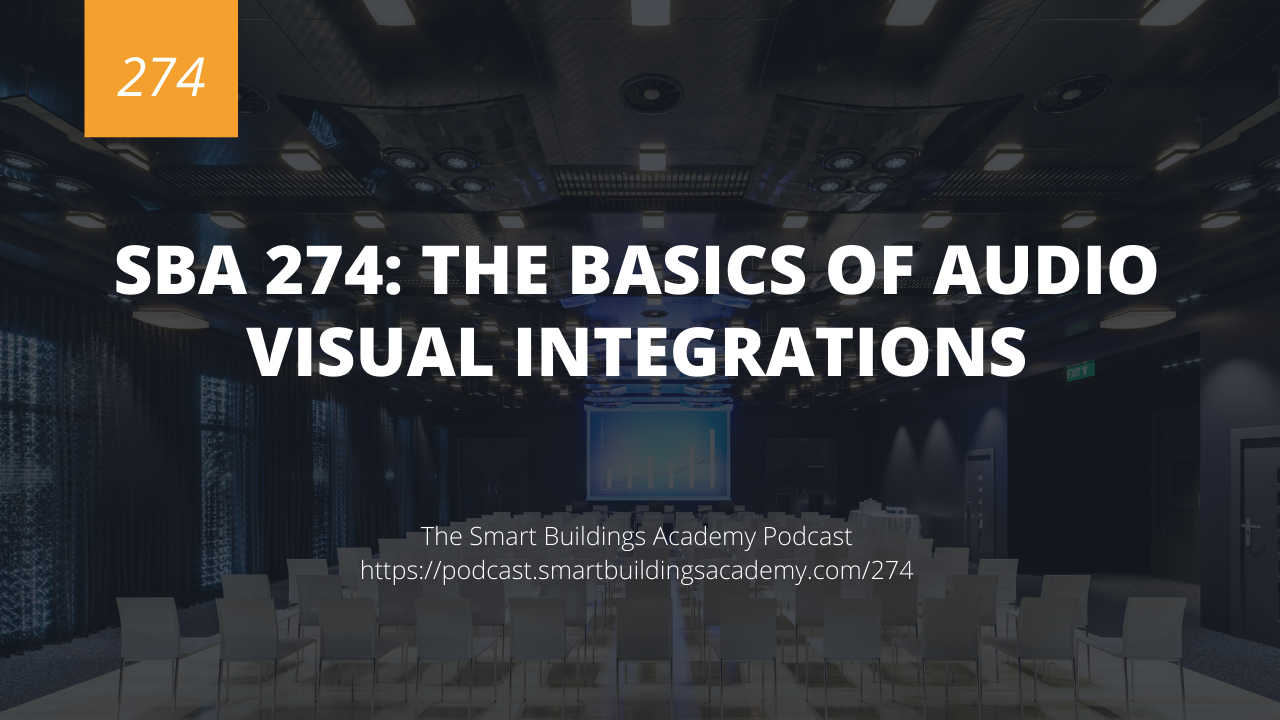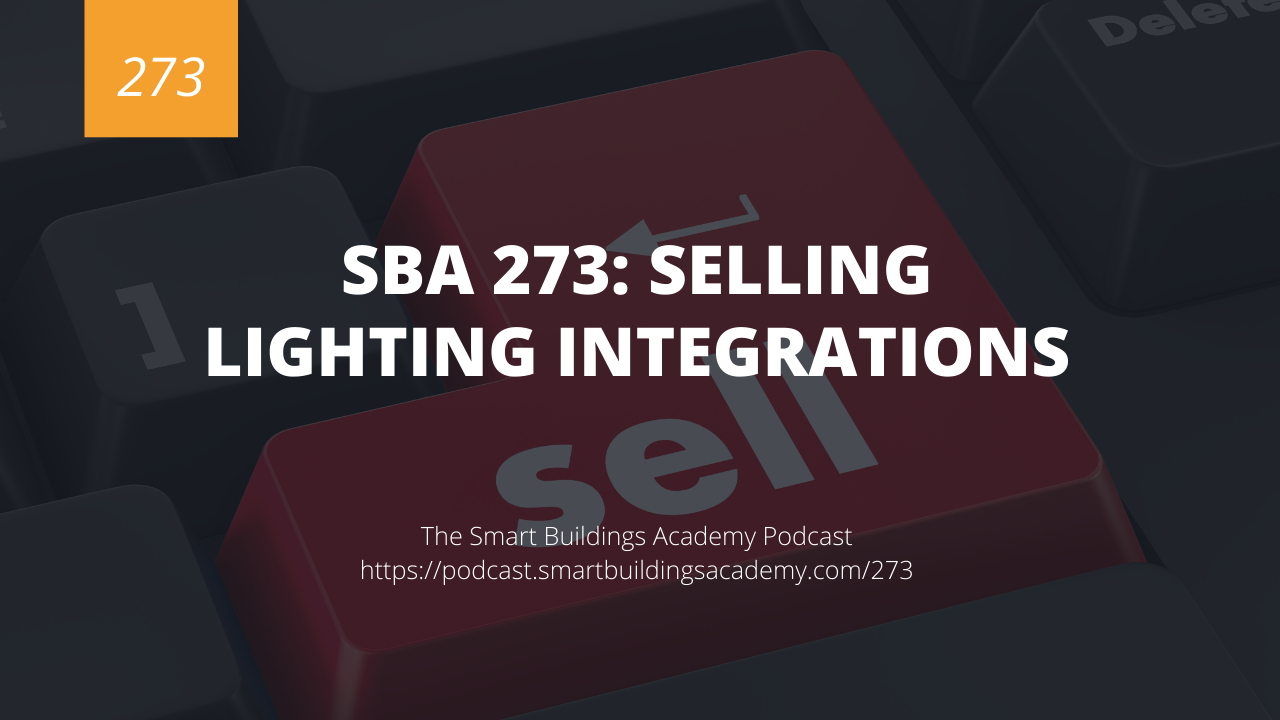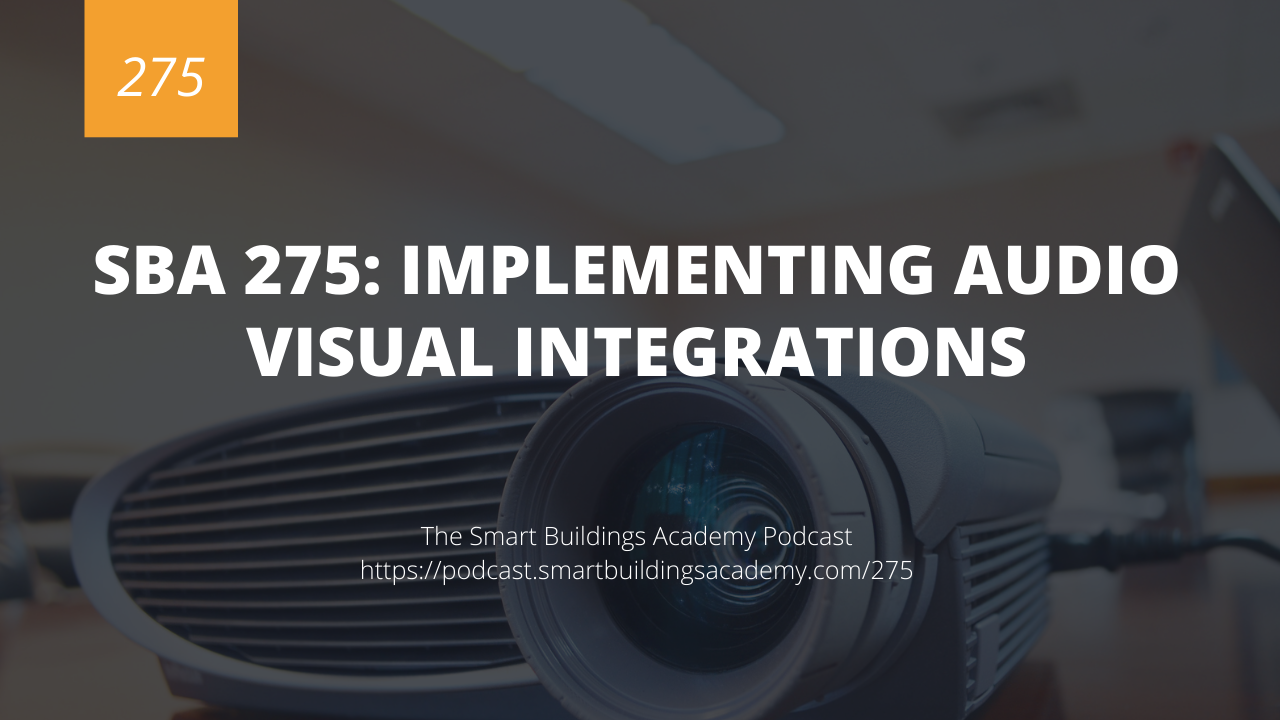Audio Visual systems are complex systems.
But when integrated into or with a building automation system they can add tremendous capabilities to the end user.
In this episode we will begin to look at the fundamentals of audio visual system integration.
Click here to download or listen to this episode now.
Resources mentioned in this episode


Transcript
Phil Zito 0:00
This is the smart buildings Academy podcast with Phil Zito Episode 274. Hey folks, Phil Zito here and welcome to Episode 274 of the smart buildings Academy podcast. In this episode, we are going to begin to look at the basics of audio visual integrations. Now, if you've been following along, you know that this is technology stack to have this integration series last week, we discussed lightning integrations. And if you haven't listened to those episodes, I encourage you to do so because we covered a lot of fundamental knowledge around integrations. And as such, these episodes moving forward are going to be a little shorter. So if some of the stuff, you're not really understanding it, I encourage you to go back listen to episodes 271 to 72 to 73. Alright, so audio visual integrations. First off, what is an audio visual system? Well, it's a system that controls the audio, and the visual components within spaces. Now, this could be things like digital signage, this could be things like conference room control. And you know, there's a lot more than just audio visual. And what we have to remember, as I discussed in Episode 271, is that with integrations, at least I think I've discussed this in Episode 271. But with integrations and systems in general, they consist of a common architecture, right, a server supervisory device, room or field controller with inputs and outputs. Well, in the case of audio visual, we have a room controller, we have inputs, and those may be microphones, those may be cameras, those may be controller or little touch pads that allow you to control the audio visual system. And then they have outputs, right those outputs may be screens, those outputs may be speakers, they may be lights, etc. Audio Visual is unique, in that it tends to control multiple subsystems, it can control the lighting, it can control, shade control, it can control telephony systems, control monitor systems, etc. and it can also control signage. So for example, outside the space, things like that the signage can be controlled via the audio visual system. Now, when we're looking at an audio visual system, from an integration perspective, we need to understand exactly what point we're cutting over. And we have to understand exactly what we're trying to do. So in my experience, there's three main ways that audio visual systems are integrated with, the first is going to be providing data to audio visual systems. Now, what we are doing here, usually there's like a touchpad inside the space. Or maybe there's a phone application that connects to the AV system. And we're providing zone temperature and zone temperature setpoint, as well as maybe an occupancy point to the audio visual system. That way, the people within the space have a single touchscreen from which they can control the lights, the temperature, the BA s, you know, occupancy, etc, as well as all of the AV subsystems. So that's a common point of integration. That's typically done via BACnet IP at the server. And then those points are cast down to the audio visual devices themselves. Another way I see audio visual systems integrated is going and taking subsystems of the AV system and pulling them into the building automation system. So the AV system may have control of shades, it may have control of lights, it may have control of occupancy of a space like on off mode for all of the technology stacks within the space, the TVs, the speakers, etc. And what we can do is we can pull all of that information and control into the BBs and then use it as like an energy control mode. So when we want to go and control the energy of the space, we could turn off unoccupied conference rooms, we can turn off lights, we could turn off audio, visuals, all of the plug load as it's called, you know, those are the two main ways that I see AV integrated. Now I am seeing an increase in people counting where people are starting to are building operators are starting to look at what amount of people are in the space, how many people are in the space, what spaces they're in, and then they're using this information to drive real time occupancy, potentially to do demand control ventilation, they're also looking at the occupancy for load. They're also pulling the occupancy data back into a greater analysis to look at space utilization so that they can do proper space planning. For their building, all in all, most audio visual systems, they're not terribly difficult to integrate. There's two main types of integration when it comes to audio visual systems. Those are going to be protocol integrations and programmatic integrations, both of which we'll discuss more on episode 275. But as an integrator, your primary goal when you're working with audio visual systems, one is to realize that the audio visual systems typically are not there like it gear right, they typically will be included in the FF and E budget, and they typically will be put in place. Once the certificate of occupancy is awarded, you typically are not going to see a V gear, all brought in during construction phase just due to the susceptibility to dust and two temperature swings, and just the damage that can be caused to this AV gear. So it brings up a little bit of a nuance from an integration perspective, in that if you are consuming data from the AV system, you're typically going to have to be setting up those integrations, post project or during the warranty phase. And that definitely has ramifications on your project billing that definitely has ramifications on your execution. Now, if you're feeding data to the AV system, usually you can feed data out, and then leave it available for discovery. But that really comes down to how detailed your building automation system data is. This is where device descriptions and objects descriptions become really important, especially if you're using BACnet as a protocol. Because as the AV vendor discovers your points, the more descriptive you can be with what the point is and what space or zone it serves, the better able they are to integrate without your support. Additionally, you need to be cognizant of priority arrays and things like that, but we'll discuss that more in the next episode. So in a nutshell, AV systems allow us to control the audio and visual systems, as well as potentially lighting, shade control, and digital signage for spaces. And they also allow us to understand utilization of spaces. There's two primary ways we integrate with them protocol integration and programmatic integration. And there's really, you know, two to three primary use cases, use case one being providing building automation data to the AV system for single point control for the end user in the space. The second is for energy monitoring and energy,
Phil Zito 7:36
demand limitation, limitation, stuff like that, right where you are going and looking at, hey, we need to load shed, let's turn off all of this AV gear etc. And then our third is people counting and space utilization, really understanding how our spaces are being utilized, so that we can properly plan for space utilization in the future. So that's AV, like I said, these episodes are going to be a little shorter and a little more direct. If you didn't understand some of the core concepts, or you felt like this was very surface level, I'd encourage you to listen to episodes 271 and 272. Because those episodes will provide kind of the foundational knowledge on which I am communicating everything to you right now. In our next episode, Episode 275, we're going to look at implementing we're going to talk through protocol implementation programmatic integration, and we're going to talk through the three use cases and how they would be implemented. As always, everything's available at podcast dot smart buildings academy.com for slash 274. There you will find our system integration guide. It is a free guide. It's very long, and it will detail the MSI process to you step by step so that you can build out your integrations. Additionally, if you want to take it a step further, I encourage you to check out our system integration bootcamp where we will walk you through everything from selling integrations, to designing input integrations, does specifying integrations, implementing integrations and supporting integrations? So if you've been looking to get into MSI work or you're interested in MSI workmaster systems integrator work, I encourage you to go to podcast smart buildings academy.com for slash 274 to learn more. Thanks a ton for being here. I look forward to seeing you in a future episode. Take care





